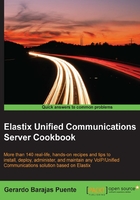
Introduction to Elastix Unified Communications System
There is a revolution going on in the telecommunications field these days. The world is getting smaller, bandwidth is growing, and protocols are getting increasingly standardised, open, and stable.
It was in 1999 when Mark Spencer began a very important project: Asterisk PBX. The advantages of open source licensing allowed this project to develop features unachievable using traditional telephony devices, at very competitive prices.
Nowadays, enterprises are not merely looking for telephonic solutions (PBX) anymore; they are looking for integrated, complete, and out-of-the box solutions that allow them be as productive as possible. They want to keep their co-workers connected, reachable, and available at all times. If a CTO calls any coworker and the call is not answered, because the person was at the lobby receiving a customer, it will be routed to this coworker's cellular phone, which happens to have a Session Initiation Protocol (SIP) client registered to the PBX using the wireless LAN of the building.
The cost of this call is almost $0. However, if this coworker does not answer his cell phone, this call can be forwarded to a voicemail. The Voicemail System can send the voice message to an e-mail and when this person arrives at the office, he will have the "message waiting" indicator LED on his phone notifying him that he has a voice message.
Elastix's brief history
We all know that Asterisk runs on Linux and has gained so much attention that it has made system administrators, integrators, developers, and tech-savvy individuals see a big opportunity in business, but sometimes their knowledge of Linux is limited. This has led to projects such as FreePBX, Trixbox, AsteriskNOW, Elastix, and PBX in a Flash that fulfill the need to configure and administer Asterisk PBX without being a Linux expert.
However, Edgar and José Landívar of Palosanto Solutions went far beyond this. In March 2006, they released the first version of Elastix. This first version was only a visual reporting tool, and by December 2006, Elastix was officially released as a Unified Communications suite using Linux CentOS as the operating system.
The project began to gain attention because all the communications software was completely integrated and available with the PBX engine. There was no need to recompile the fax system, for example. You just had to configure it. There was no need to recompile the drivers for a public switched telephone network (PSTN) card. You only had to install it physically on your server (or PC), Web-GUI would detect the card, and you would be able to configure it as well.
In many Latin American countries, digital E1 telephony lines use a very old and limited protocol called Multi-Frequency Compelled R2 (MFC/R2 or just R2). In order to make this kind of telephony lines and cards support MFC/R2 for Asterisk, there is a module from an abstraction layer called Unicall (by Steve Underwood) that must be downloaded and compiled; after this patch, Asterisk has to be recompiled. This situation was very stressful for many aficionados. However, thanks to Palosanto Solution's view, since the first release of Elastix, this library has been compiled and installed. Users just needed to configure all the parameters to have their R2 E1 lines work with Asterisk.
Later, with the help of Moisés Silva (the creator of the Openr2:MFC/R2 signaling library), the support for MFC/R2 protocol was much easier. Providing support for the Spanish language gave Elastix a big advantage over other open source telephony distributions. This innovative "vision" has made this project very important these days in the open source telephony solutions community. Today, Palosanto Solutions have achieved a long list of awards and more than one million downloads.
What is Elastix?
Elastix is an open source unified communications platform that uses Community Enterprise Operating System Linux(CentOS) as the operating system. The best way to describe Elastix is with the following diagram:

As you can see, the elements involved in Elastix's architecture allow any user or enterprise to use the PBX as a gateway to the PSTN, and incorporate many other tools, programs, and elements to communicate in a more efficient way.
For example, users can receive a fax in their e-mail account, or they can have remote extensions in order to integrate all office branches and use them as a single entity to reduce call costs.
Users can also start video calls and video conferences by using their own devices such as cell phones and tablets.




